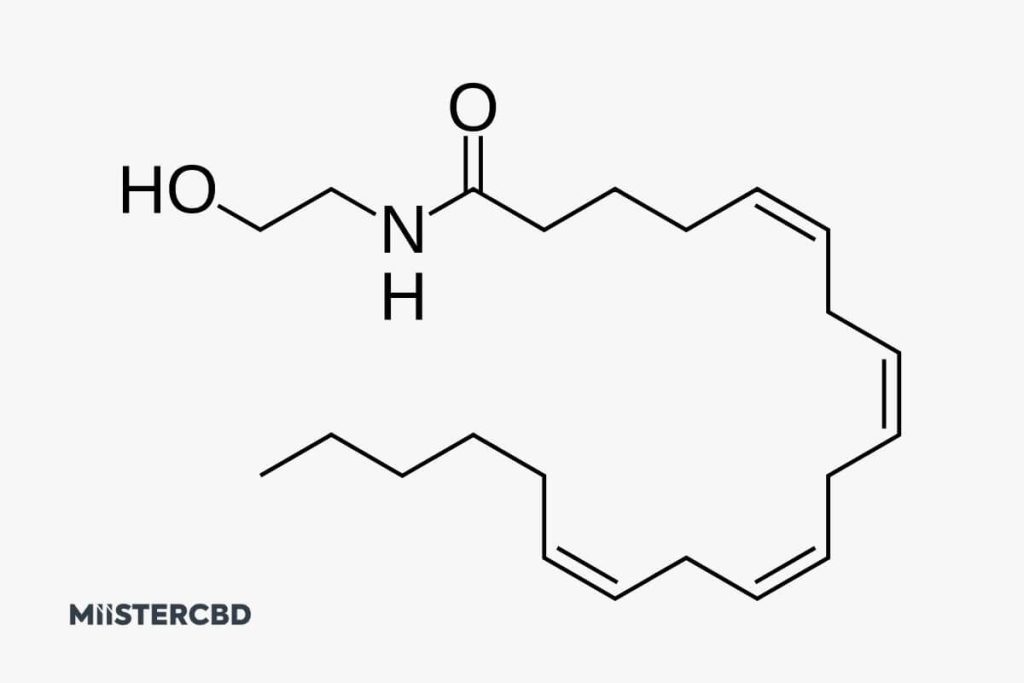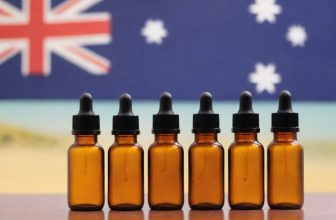Key Takeaways :
- Anandamide, also known as the “bliss molecule,” is a natural endocannabinoid that interacts with CB1 and CB2 receptors to help regulate mood, pain, appetite, and sleep—playing a key role in overall well-being.
- A fleeting yet powerful compound: Unlike THC, anandamide is quickly broken down by the body, limiting its short-term effects. However, certain natural elements like dark chocolate or physical activity can help extend its presence.
- A newcomer to the CBD market: Anandamide is now being included in innovative CBD products, offering a soothing and natural option for those looking to better manage stress and emotional balance.
Do you know your happiness molecule? Anandamide is an essential endocannabinoid produced naturally by our bodies. This molecule plays a crucial role in the endocannabinoid system, influencing our mood, appetite, memory and pain management. With the recent arrival of AEA on the cannabinoid market in Europe, here's an article to find out all about this much-coveted molecule.
What is Anandamide? Definition, composition and origin
Anandamide is an endocannabinoid, a natural compound produced by our bodies, and an integral part of the endocannabinoid system. Discovered in the 1990s, its name comes from the Sanskrit word “ananda”, meaning happiness or bliss, hence its nickname of “happiness molecule”.
Anandamide acts as a neurotransmitter, binding to CB1 and CB2 receptors in the brain and central nervous system. It is often compared to THC, the main psychoactive compound in cannabis, as their chemical structures are similar, allowing THC to mimic the action of anandamide in our bodies.
Think of anandamide as an internal messenger circulating in your brain, slipping onto CB1 and CB2 receptors. However, unlike THC, anandamide is produced on demand and is rapidly degraded by enzymes such as FAAH, limiting its duration of action. As an endocannabinoid, it plays a role in regulating mood, appetite, memory and even pain management.
Scientists are fascinated by this molecule, which helps maintain the biological balance or “homeostasis” in the body. Research indicates that its levels influence our general well-being, reinforcing scientific interest in its effects and therapeutic potential.

The role of Anandamide in the endocannabinoid system
Anandamide plays a key role in the endocannabinoid system, binding primarily to CB1 and CB2 receptors in the brain and other parts of the body. These interactions are fundamental to the regulation of various essential biological functions.
By activating CB1 receptors, found mainly in the central nervous system, anandamide influences processes linked to mood, memory and stress management. For example, this interaction contributes to feelings of well-being, hence its nickname of “happiness molecule”.
For its part, the CB2 receptor, more present in the immune system, is involved in the modulation of pain and inflammation, enabling anandamide to intervene in the body's response to chronic pain and inflammation. Unlike other neurotransmitters stored in reserve, anandamide is produced on demand in response to the body's specific needs.
This targeted release helps maintain homeostasis, or internal balance, by rapidly adapting the body's responses to stimuli. In this way, anandamide plays a central role in regulating emotions, physical comfort and eating behaviors, making it a molecule of interest to health and well-being researchers.
Effects and benefits of Anandamide
| Effects | Benefits |
| Mood regulation | Reduce stress and improve well-being |
| Pain management | Reduced pain and inflammation |
| Appetite stimulation | Reinforcing pleasure circuits linked to food |
| Sleep aid | Facilitates relaxation and rest |
Anandamide, nicknamed the “happiness molecule”, has a wide range of effects on body and mind, thanks to its interaction with the endocannabinoid system. This molecule plays a crucial role in mood regulation by influencing CB1 receptors, associated with sensations of pleasure and anxiety reduction.
Research suggests that high levels of anandamide can improve mood and reduce stress, contributing to overall well-being. By also acting on CB2 receptors, anandamide helps reduce pain and inflammation, making it relevant to the management of chronic pain.
It also influences appetite and sleep, two functions essential to the body's equilibrium. For example, anandamide is involved in the reward circuits that reinforce the pleasure associated with food consumption, naturally stimulating appetite.
As for sleep, although not a sedative, anandamide contributes to relaxation, facilitating better rest. In short, this molecule plays an essential role in modulating mood, pain, appetite and sleep, bringing balance and a sense of well-being.
Anandamide and cannabinoids: comparison with THC and CBD
| Property | Anandamide | THC | CBD |
| Connection to receivers | CB1 and CB2 | CB1 and CB2 | Indirect (inhibits FAAH) |
| Effects | Short, mood modulator | Long, psychotropic effect | Non-psychotropic, relaxing |
| Degradation | Fast by the FAAH | Slow | Increases anandamide |
Anandamide and THC share structural similarities, enabling THC to bind to CB1 and CB2 receptors of the endocannabinoid system, like anandamide, to produce comparable effects. THC thus mimics the action of anandamide by activating CB1 receptors, producing longer-lasting psychotropic effects as it is more resistant to enzymatic degradation.
Anandamide, on the other hand, is rapidly degraded by the FAAH enzyme, making its effects more ephemeral.
CBD, on the other hand, acts differently: it does not interact directly with CB1 and CB2 receptors, but inhibits the activity of FAAH. By slowing down this enzyme, CBD prolongs the presence of anandamide in the body, increasing its effect without triggering psychotropic effects.
This indirect modulation makes CBD a central player in enhancing anandamide levels and, consequently, its potential beneficial effects on mood, pain and anxiety.
Can Anandamine levels be increased in the body?
Want to boost your “happiness molecule” naturally? Good news: it's possible, and not at all complicated!
It is possible to naturally increase anandamide levels in the body through a few simple habits. Exercise is one of the most effective ways: after around 30 minutes of exertion, anandamide levels rise, contributing to the post-workout feeling of well-being often referred to as “runner's euphoria “.
The consumption of certain foods can also play a role. Dark chocolate, for example, contains substances that slow down the breakdown of anandamide, prolonging its effects. Black truffles are another rare source of anandamide, which may explain their “comforting” effect.
Genetic factors also influence anandamide levels: some people have a mutation in the FAAH gene, responsible for its breakdown, which naturally increases their anandamide levels and may make them less prone to anxiety. These factors combined show that it is possible to partially modulate anandamide production to promote better emotional balance.
Methods for naturally increasing Anandamide
- Physical exercise: increases anandamide levels after about 30 minutes.
- Dark chocolate: contains compounds that inhibit anandamide degradation.
- Black truffles: a rare source of anandamide.
- Genetics: mutation of the FAAH gene, which slows down the degradation of anandamide.
Anandamine enters the legal cannabinoid market
With the arrival of anandamide (AEA) in CBD online stores like CBD'eau, consumers can now discover the benefits of this natural molecule, renowned for its wellness and relaxation effects.
For example, Space Resin AEA 6% + CBN 20% combines anandamide with cannabinol (CBN) to deliver a unique, synergistic experience. Thanks to this combination, users benefit from deep soothing and enhanced emotional balance, all in a high-quality formulation.
Space AEA resin meets the needs of those looking for a natural and innovative alternative to manage stress and improve their general well-being. Numerous products will soon land on the best CBD sites. AEA has the potential to become a landmark innovation on the market, with the promise of new sensations and optimal relaxation eagerly awaited by cannabinoid enthusiasts.
Follow us on 
Join the Community
Don't miss any news with our newsletter





